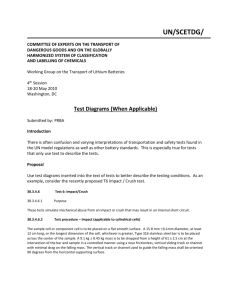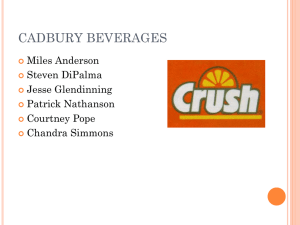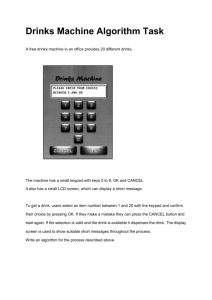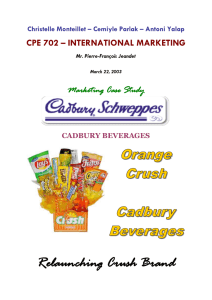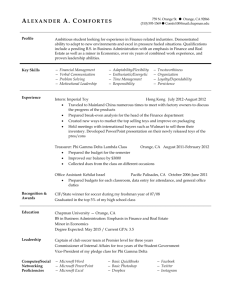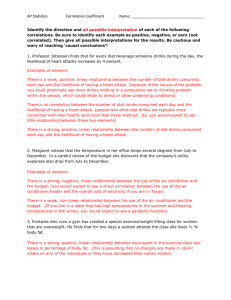CADBURY BEVERAGES, Inc
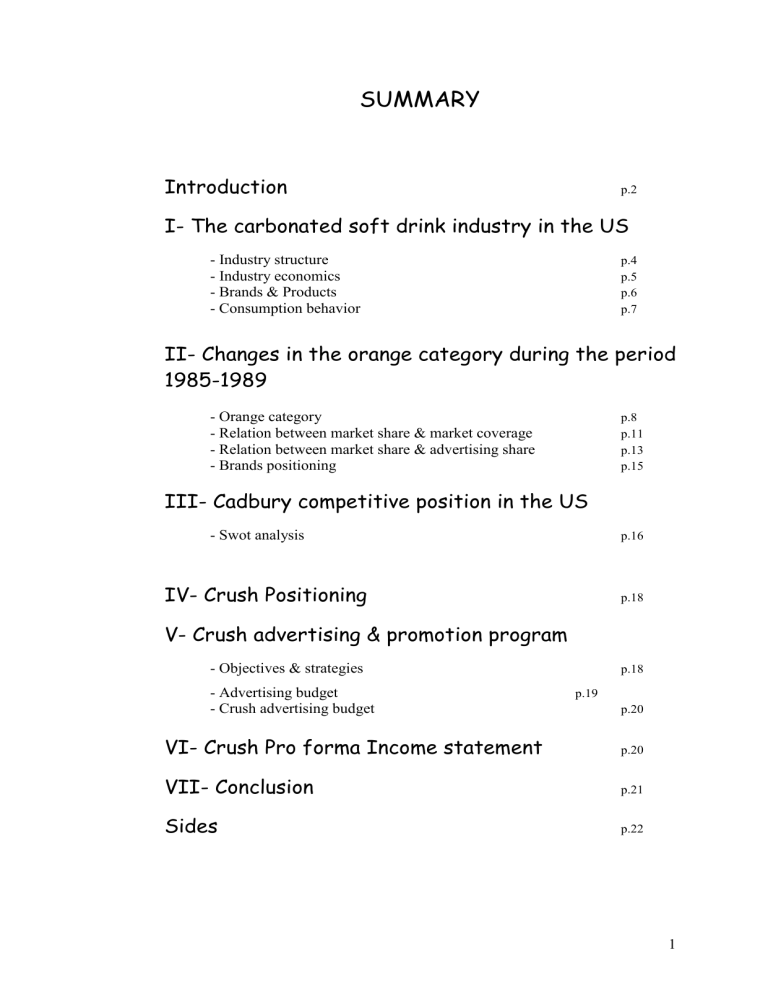
SUMMARY
Introduction
p.2
I- The carbonated soft drink industry in the US
- Industry structure
- Industry economics
- Brands & Products p.4 p.5 p.6
- Consumption behavior p.7
II- Changes in the orange category during the period
1985-1989
- Orange category
- Relation between market share & market coverage
- Relation between market share & advertising share
- Brands positioning
III- Cadbury competitive position in the US
p.8 p.11
p.13 p.15
- Swot analysis
IV- Crush Positioning
V- Crush advertising & promotion program
p.16 p.18
- Objectives & strategies
- Advertising budget
- Crush advertising budget
VI- Crush Pro forma Income statement
p.19
VII- Conclusion
Sides
p.18
p.20 p.20
p.21
p.22
1
INTRODUCTION
Cadbury Beverages, Inc. is a beverages-manufacturing division of Cadbury
Schweppes PLC. It was created in 1969 by a merger of Schweppes PLC (1783,
London, the first world’s soft drink maker) and Cadbury (1830, Birmingham, a major British confectionery manufacturer).
In 1989, the Cadbury Schweppes PLC was one of the world’s largest multinational companies and the world’s third largest soft drink marketer (behind
Coca-Cola and PepsiCo), with worldwide sales of $4.6 billion, performed in 110 countries. Beverages accounted for 60 percent of company sales and 53 percent of its operating income.
Additionally, at that time, Cadbury Beverages, Inc. was the fourth biggest soft drink marketer in the US (behind Coca-Cola, PepsiCo, Dr.Pepper-7Up), with a carbonated soft drink market share of 3.4 percent, and the market leader in some specific soft drinks categories (see exhibit 1).
EXHIBIT 1.
Brand name Leader in category
Canada Dry Ginger ale, soda/seltzer
Sunkist Orange-flavored carbonated
% of the US soft drink sales
39
22
Crush
Schweppes soft drinks
Tonic water
20
17
2
In January 1990, the Cadbury marketing team decided to take up a challenge of relaunching the Crush, Hires and Sun-Drop soft drink brands, recently acquired from Procter&Gamble (October 1989). In the beginning, the marketing executives intended to focus on relaunching the Crush brand on the soft drinks market. As a result, three main issues need to be tackled:
rebuilding a cooperative relationship with bottlers,
developing a base brand positioning consistent with the brand equity,
developing (objectives, strategies) and budgeting the advertising and promotion program.
3
I- THE CARBONATED SOFT DRINK
INDUSTRY IN THE UNITED STATES
Industry Structure
Three main actors participate in manufacturing and distribution of carbonated soft drinks in the United States: concentrate producers, bottlers, and retailers. The concentrate producers’ and bottlers’ roles and margins of are different for regular and diet drinks (see Exhibit 2).
EXHIBIT 2.
1. Regular soft drinks:
Actors
Carbonate
Producers
-
Functions manufacture the basic flavors
Gross
Margin
86%
Net
Margin
16%
46% 15% Bottlers
2. Diet soft drinks:
add sweetener to carbonated water
package in bottles and cans
Actors Functions Gross
Margin
87%
Net
Margin
30% Carbonate
Producers
Bottlers
manufacture the basic flavors
include an artificial sweetener
add carbonated water
package in bottles and cans
43% 12%
4
There are approximately 40 concentrate manufacturers in the US, but only three of them (Coca-Cola, PepsiCo, and Dr. Pepper/7Up) account for 82 percent of industry sales. As far as bottlers are concerned, they are present in a number of
1,000 in the United States. They may be either owned by concentrate producers, or franchised. Franchised bottlers are usually given the exclusivity rights for a certain territory, but they cannot sell a directly competitive brand.
Concerning retailers, those are supermarkets (40 percent of carbonated soft drink industry sales), convenience stores and small retail outlets, vending machines, and fountain service (ex. McDonald’s). Among the above mentioned, supermarkets are claimed to be crucial in the company’s distribution net.
Industry Economics
Concentrate producers typically arrive at a gross profit of 86% (regular drinks), or
87% (diet drinks). When we take off selling and delivery, advertising and promotion costs and general and administrative expenses, the net profit may reach either 16% (regular drinks), or even 30% (diet drinks).
On the other hand, the gross profit for bottlers usually accounts for 43% (diet drinks), or 46% (regular drinks), whereas the net pretax profit gets at 12% (diet drinks), or 15% (regular drinks).
In view of the analysis of the above cost structure it seems obvious that concentrate producers should be more interested in manufacturing diet soft drinks, and bottlers are supposed to slightly prefer mixing and packing regular drinks.
5
Brands and Product Categories
Brands
More than 900 brands are registered on the US market, however most of them sell their product on local markets. The most successful 10 brands are marketed by 3 major concentrate producers: Coca-Cola, PepsiCo, and Dr.Pepper/7Up, of which the US market share accounts for 71.4 percent (see Exhibit 3). Six of these top brands are colas (56.4 percent of market share).
EXHIBIT 3.
Brand
1.
Coca-Cola Classic
2.
Pepsi-Cola
3.
Diet Coke
4.
Diet Pepsi
5.
Dr. Pepper
6.
Sprite
7.
Mountain Dew
8.
7Up
9.
Caffeine-free Diet Coke
10.
Caffeine-free Diet Pepsi
Market Share
19.8%
17.9%
8.9%
5.7%
4.5%
3.7%
3.6%
3.2%
2.5%
1.6%
Top ten brands:
Colas:
Regular:
Diet:
Other brands:
71.4%
56.4%
37.7%
18.7%
28.6%
6
Flavors
As far as flavors are concerned, cola one is the most popular with market share accounting for 65.7 percent. Other successful flavors are lemon-lime (12.9 percent of market share), orange (3.9%), root beer (3.6%), ginger ale (2.8%), and grape
(1.1%) ones. The flavor of our concern, orange, occupies the third position, after cola and lemon-lime, with market share of some 3.9¨%.
Regular vs. Diet
The carbonated soft drink market is divided into two parts: regular soft drinks and diet soft drinks. The consumption of diet soft drinks accounts for 31% of total soft drink consumption and is higher among consumers over 25 years of age.
Consumption Behavior
Buyers
Concerning consumption behavior, the soft drink buyers seem to be very responsive to different advertising and promotion techniques (especially to coupon promotions, in-store displays ex end-of-aisle displays, and other promotions in the place of sale ex shelf tags). Also, it appears that the purchase of soft drinks (mostly in supermarkets, accounting for 40% of carbonated soft drink industry sales) is often unplanned.
The US customers drink more soft drinks than tap water, the average American consumes 46.7 gallons of carbonated soft drinks per year (in 1989 compared to the 23 gallons in 1969). The typical customer purchasing soft drinks is a married woman with children under 18 years of age living at home.
Seasonal and Geographical Variations
The consumption of carbonated soft drinks differs slightly according to a season: it is more pronounced in summertime than in wintertime. Moreover, there seems
7
to exist some geographical differences. The highest per capita carbonated soft drinks’ consumption in the United States (54.9 gallons in 1989, compared with the national per capita average of 46.7 gallons) was noted in the East South Central states of Kentucky, Tennessee, Alabama, and Mississippi. The lowest per capita carbonated drinks’ consumption (37.1 gallons in 1989) was that of the Mountain states (Montana, Idaho, Wyoming, Colorado, New Mexico, Arizona, Utah, and
Nevada).
II- CHANGES IN THE ORANGE CATEGORY
DURING THE PERIOD 1985 – 1989
Orange Category
In 1989 the total sales in the orange-flavored carbonated drink category were of
126 million cases, which means 3.9% of total industry sales through supermarkets.
Four major brands make the core of this category (see Exhibit 4): Mandarin
Orange Slice by PepsiCo (the category leader with a market share of 20.8%),
Sunkist by Cadbury Beverages, Inc. (14.4 % of the total market share), Coca-
Cola’s Minute Maid Orange (14%), and Orange Crush (7.5%).
EXHIBIT 4. Market Shares for the 4 Major Orange Category Brands.
8
MOS
MMO
Sunkist
Crush
Others
Both regular and diet drinks are present within the orange-flavored carbonated soft drink category, the regular accounting for 73.2% of the category sales in average. For more details, see exhibit 5.
EXHIBIT 5. Case Volume in 1989 by Type of Drink: Regular vs. Diet
Brand Regular Diet
Crush 71.3% 28.7%
Sunkist 82.1 17.9%
MOS 49% 51%
MMO 53.1% 46.9%
The shares accounting for diet orange soft drinks are considerably higher for
Mandarin Orange Slice and Minute Maid Orange (51% and 49%) than for
Cadbury orange-flavor brands (Crush: 29% and Sunkist:18%), since their positioning is based on the young singles and young couples and therefore corresponds to the diet drinks’ consumption patterns. This may present an opportunity for Crush, of which orange diet version could be repositioned as the one that is drunk by young people (singles and couples) living in big cities, in opposition to family-based positioning of Crush and Sunkist.
9
Changes in the Orange Category Sales and Market Shares in
1985-1989.
During the period of 1985-1989, the total sales in the orange carbonated drinks’ category increased by 23.5%, from 102 million cases to 126 million cases (see exhibit 6). This evolution was due to the launch in 1985-1986 of Mandarin
Orange Slice (MOS) and Minute Maid Orange (MMO) by respectively PepsiCo and Coca-Cola, which, accompanied by intensive advertising, promotion, and distribution-rejuvenating efforts, revitalized the category. As a result of the above change, market shares of main competitors have been subject to some major changes (see Exhibit 7). In particular, the Cadbury’s Crush and Sunkist brands lost a lot of their market share while PepsiCo’s and Coca-Cola’s newly created brands evolved in a successful way.
EXHIBIT 6. Changes in Total Orange Category Sales in 1984-1989.
Year 1984 1985 1986 1987 1988 1989
Category Sales [Million Cases]
102 100 126 131 131 126
EXHIBIT 7. Market Shares’ Changes in 1985-1989.
Brand
Year
1985 1986 1987 1988 1989
Sunkist
MOS
MMO
Crush
32% 20% 13% 13% 14%
-
-
22
16
8
18
22
14
14
21
13
11
21
14
8
Total of top 4 brands 54 62 63 58 57
Advertising Expenses
.
Annual Supermarket Case Volume of Orange-Flavored Soft Drinks in millions.
10
As for changes in advertising approach, two trends were apparent at that time.
Since 1996 (the year when MOS and MMO were introduced nationally) the total expenditures for print and broadcast media declined each year (see Exhibit 8). On the other hand, the variety of media used for advertising increased, in addition to some traditionally used media like spot television and billboards, some new ones submerged, including broadcast media (network, spot, syndicated, and cable TV and network radio) and print media (outdoor, magazines, and newspapers).
EXHIBIT 8. Concentrate Producers’ Advertising Expenditures for Broadcast and
Print Media for Major Soft Drink Brands, 1985-1989 (in thousands of Dollars).
Brand
$
1985
% $
1986
% $
1987
% $
1988
% $
1989
%
MOS 17,809 60.3 32,080 62.7 29,556 67.5 15,001 41.2 11,388 43.8
Sunkist 7,176 24.3 4,013 7.8 911 2.1 1,719 4.7 2,302 8.9
Crush 4,371 14.8 7,155 14.0 4,297 9.8 6,841 18.8 2,020 7.8
MMO 174 0.6 7,952 15.5 9,027 20.6 12,811 35.3 10,463 39.5
Total4 29,531 100.0 51,200 100.0 43,790 100.0 36,373 100.0 26,007 100.0
Relationship between Market Share and Market
Coverage
EXHIBIT 9. The Four Main Brands’ Market Shares and Market Coverage Rates,
1985-1989.
11
100
80
60
40
20
0
10
1985
0
MADARIN ORANGE SLICE
88
87
88
68
1986
16
1987
Year
22
1988
21
1989
21
SUNKIST
60
40
20
0
100
80
1985
95
32
83
1986
20
79
86
91
1987
Year
13
1988
13
1989
14
Market Share
Market coverage
Market share
Market coverage
12
CRUSH
100
80
60
40
20
0
81
22
81
18
78 78
62
Market share
Market coverage
1985 1986 1987
Year
14
1988
11
1989
8
MINUTE MAID ORANGE
100
80
60
40
60
87
88 88
Market share0
Market coverage
20
14 14
0
13
10
1985
0
1986
8
1988 1989 1987
Year
The above graphs clearly demonstrate that here is some positive correlation between the company’s market share in the carbonated orange soft drink category and its market coverage. In practice it means that if the company market coverage increases, its market share increases too. Consequently, companies in this category should focus their efforts on their market coverage evolution.
13
40
20
0
80
60
Relationship between Market Share and Advertising
Share
EXHIBIT 10. The Four Major Brand’ Market Shares and Advertising Budgets,
1985-1989.
MANDARIN ORANGE SLICE
100
60
1985
0
62
16
67
22
41
21
43
21
Market share
Advertising share
1986 1987
Year
1988 1989
14
SUNKIST
100
80
60
40
20
0
1985
32
24
1986
13
1987
Year
2
CRUSH
1988
13
4
1989
14
8
100
80
60
40
20
0
1985
60
40
20
0
100
80
1985
22
15
1986
18
14
1987
Year
14
9
1988
18
11
MINUTE MAID ORANGE
1989
36
1986
8
1987
Year
20
14
35
1988
13
40
1989
14
Market share
Advertising share
Market share
Advertising share
Market share
Advertising share
15
Brand Positioning
The four main competitors in the orange carbonated soft drink category tried to adopt different positioning strategies for their products. Some of them stressed the orange flavor of their products (Minute Maid Orange), some others attempted to associated drinking their product with a specific lifestyle (teens lifestyle for
Sunkist). Also, they targeted different age groups and household models:
Mandarin Orange Slice and Minute Maid Orange focused their attention on young adults with no children (singles, couples) while putting stress on “better for you” idea (health, fit, vitamins, natural). The Cadbury Beverages’ Brands traditionally aimed at families with children and teens at home (see Exhibit 11).
EXHIBIT 11. The Four Major Brands Positioning Strategies, 1989S.
Family with children at home
Teens & young adults
Orange taste ute ee ute ma id
KEY :
Crush :
Minute Maide orange :
Mandarin Orange slice :
Sunkist :
16
There appears to be a positive correlation between marketing coverage and marketing share, which means that if the market coverage increases, the corresponding market share increases too.
As far as market shares are concerned, a positive correlation seems less pronounced, but still present. Also, companies’ advertising and promotion strategies seem different: while Sunkist and Crush spend less on advertising and use less advertising vehicles, Coca Cola & PepsiCo spend a lot even if they win a small market share. In their promotion campaigns they use a variety of media.
Concerning our positioning recommended for Crush, we will describe it later in this report.
III- CADBURY COMPETITIVE POSITION IN
THE US SOFT DRINK INDUSTRY
Cadbury Beverages is the American fourth biggest soft drink manufacturers, behind Coca-Cola, PepsiCo, and Dr. Pepper/7Up, with a market share of 3.4%.
The company’s brands are often market leaders within their categories. The major
Cadbury brand’s sales (in relative terms) are presented on Exhibit 1
In 1989, the orange category market share accounted for 3.9% of the total soft drinks’ market share. Cadbury was in the leading position within this category, with its market share of 22% for both Sunkist (14%) and Crush (8%) brands.
Concerning competitors, the market share for the Coca-Cola’s Minute Maid
Orange accounted for 14% (1989), and the PepsiCo’s Mandarin Orange Slice market share for about 21% (1989). For graphical presentation, see Exhibit 4.
17
SWOT Analysis
To complete the analysis of a Crush competitive position in the orange soft drink category as well as within the soft drink industry, we employed the SWOT analysis scheme. The major strengths, weaknesses, opportunities and threats are presented on Exhibit 12 below.
EXHIBIT 12. The SWOT Analysis for the Crush Orange Carbonated Soft Drink
Brand.
STRENGHTS
INTERNAL FACTORS
WEAKNESSESS
4th largest marketer in the US
High name
Long-life brand
Know-know
High brand awareness in big cities
Low market share
Low market coverage
Limited bottlers network
Relatively low ad & promotion expenditures
Risky positioning cannibalization with Sunkist
:
EXTERNAL FACTORS
OPPORTUNITIES THREATS
Variety of medias vehicles
Increase in sales for diet soft drinks
Increase of consumption
Huge competition
Heavy advertising expenses
Unplanned soft drink purchase
18
IV- CRUSH POSITIONING
Three approaches can be considered to position the Crush brand:
- Attributes : Natural & competitive taste since 1954
Bright color
Regular & diet
- Uses : Orange Crush drinking for fun :during parties & week-end
Orange is better for health than colas: natural vitamins
- Users : Orange can be drink by adults, teens and children
We avoid canibalization with Sunkist
We target family with children
Concerning our positioning recommended for Crush we decided to reposition this brand on the family with children market segment (as differentiated from Sunkist
“families with teens” to avoid cannibalization effect). Moreover, we recommend to position Crush Diet in a different way: by focusing on young singles and couples (above 24 years old), living in big cities (where Crush is well-known), and associating its consumption with healthy, natural, dynamic lifestyle). This would enable a strategy that would be more consistent with the consumption profile of diet drinks’ consumers.
V- CRUSH ADVERTISING AND PROMOTION
PROGRAM
Objectives and Strategies
While deciding on our strategy we had some clear objectives in mind. First of all we thought that the efficient distribution network (bottlers, retailers) is one of the key success factors in the soft drink industry. That is why we set up as one of our priorities a rapid and substantial broadening of our cooperation with bottlers in
19
order to be able to relaunch the Crush brand successfully. Obviously, we considered it also as a way of increasing our market share in the orange soft drink category. Our objective is then a 10% market share for Crush alone in the orange drink category at the end of 1990 (an 8% market share was recorded in 1989).
Finally, we need to relaunch the Crush brand name by developing its basic positioning, advertising and promotion strategy, and their successful implementation. Also, ongoing control of results should be carried on and strategy adjustments applied if necessary.
In view of the above quoted objectives our strategies for the Crush relaunch are following: in the beginning we need to recruit new bottlers: for this purpose we decided to employ the push strategy, which means using our distribution channels to obtain the largest possible market share. Also, as the market in question is very responsive to advertising and promotion, we need to take it into consideration and implement in parallel to the push strategy the pull strategy. This will require using an increased portfolio of medias (as Coca-Cola and PepsiCo do), as well as developing merchandising and sponsoring activities. For relaunching the Crush brand, some specific promotional techniques, such as coupons, special volume offers, contests, may be employed to attract the maximum of customers.
Advertising Budget :
BRANDS ADVERTISING
EXPENDITURES
SUNKIST
CRUSH
Mandarine
Orange
Slice
Minute
Maid
Orange
2,301,900
1,853.6
11,388.1
10,463.1
MARKET
SHARE %
MARKET
SHARE /
CASES
14 44,1000.0
8 25,200.0
21 66,150.0
14 44,100.0
ADVERTISING
$ SPENT PER
CASE
0.05
0.07
0.17
0.23
20
Crush advertising budget :
Budget : - General : $11,970,000
- Diet : $4,189,500
- Regular : $7,780,500
So we allocate $0.38
per case.
Allocation : - $0.18 for « dealer loader » ( premium given to retailers)
- $0.20 for promotion that we divides as follow : $0.1 for displays
& outdoor, $0.05 for TV spots and 0.05 for magazines.
VI- CRUSH PRO FORMA INCOME STATEMENT
Total sales
Cost of goods sold
Gross profit [$]
Gross profit [%]
Selling and Delivery
Advertising &Promotion
General & administrative expenses
Pretax cash profit [$]
Pretax cash profit [%]
Regular (65%) Diet (35%) Regular &Diet
15561000 10143000 25704000
2252250 1323000
13308750 8820000
3575250
22128750
85,53
409500
7780500
15,79
86,96
220500
4189500
2661750 1433250
2457000 2976750
29,35
86,09
630000
11970000
4095000
5433750
21,14
CONCLUSION
We should avoid direct competition with Coca-Cola & PepsiCo, it could bring on a price war. No frontal attack means that Cadbury remains a niche marketer.
21
We avoid cannibalization with Sunkist in positioning the Crush brand name on the family with children at home segment. As far as diet Crush is concerned, we reposition it as a healthy and rich in vitamins, energetic drink for young people living in big cities.
Finally, we have no choice but to increase advertising & promotion expenditures in order to reach our market share and repositioning objectives.
22
23
